UVA Library Exhibition Showcases Powerful Century Old Portraits of Black Virginians and More
UVA Library Exhibition Showcases Powerful Century Old Portraits of Black Virginians and More
Posted on September 14, 2022 by Molly Minturn
“Visions of Progress: Portraits of Dignity, Style, and Racial Uplift,” a new exhibition at the University of Virginia’s Albert and Shirley Small Special Collections Library, showcases portraits that African Americans in central Virginia commissioned from the Holsinger Studio during the first decades of the 20th century. The photographs expressed the individuality of the women and men who commissioned them, while silently yet powerfully asserting their claims to rights and equality. Opening Sept. 22, the exhibition is the result of years of research by UVA professors, students, and community members.
Susie Smith (1891-1961) was born in Albemarle County to Ferrell Smith and Annie Lee Smith. She worked as a chambermaid, housekeeper, and cook for families in the Charlottesville area. In 1912, Smith married Maryland Brown. Smith’s portrait illustrates a sense of style and self that did not rely on white middle-class values.
John Edwin Mason, a UVA associate professor of history and a documentary photographer, first learned about the Holsinger Studio Collection, held in the Small Special Collections Library, when he saw a small exhibition at the UVA’s Woodson Institute, curated by the late professor Reginald Butler and professor Scot French (now of the University of Central Florida) in 1998. The collection, which UVA acquired in 1978, includes about 10,000 glass plate negatives taken by the Holsinger Studio of life in Charlottesville and Albemarle and Nelson counties from the 1890s to the 1920s. Many of the photographs were commissioned portraits and more than 600 of those portraits are of African American citizens in central Virginia. Mason was immediately intrigued.
“I thought that we could use these portraits not simply to enjoy for their beauty as aesthetic objects, but we could see history through them, we could tell history through them. By researching the lives of the people in the photographs, we can learn a lot about the history of this place,” he said.
The portraits were taken during the height of the Jim Crow era, when state laws enforced racial segregation in the South, the Ku Klux Klan had local chapters in the Albemarle region, and a wealthy, white UVA alumnus successfully commissioned two statues of Confederate leaders (Robert E. Lee and Thomas “Stonewall” Jackson) to be erected in Charlottesville parks. “It was an incredibly oppressive time,” Mason said. “But the magic of these portraits is that you don’t see the oppression in them. And that was intentional on the part of the people who had their images made. They are saying, ‘We are not who you think we are. We are not those stereotypes, we are not defined by our status in Jim Crow society.”
A community effort
 Anthony T. Buckner (1845-1923) was born into slavery in Spotsylvania County, Virginia. By the time he commissioned this portrait of himself and his granddaughter, Eileen Buckner (1909-1985), he had become one of the most respected merchants in the Charlottesville. His son, George W. Buckner, who was Eileen’s father, wrote the New Negro manifesto that was published in the Charlottesville Messenger in 1921.
Anthony T. Buckner (1845-1923) was born into slavery in Spotsylvania County, Virginia. By the time he commissioned this portrait of himself and his granddaughter, Eileen Buckner (1909-1985), he had become one of the most respected merchants in the Charlottesville. His son, George W. Buckner, who was Eileen’s father, wrote the New Negro manifesto that was published in the Charlottesville Messenger in 1921.
In 2015, Mason turned his interest in the photos into action. He launched the Holsinger Studio Portrait Project, to delve into the lives of the portrait subjects; a partnership with the Institute for Advanced Technology in the Humanities director Worthy Martin in 2018 provided the project with a web presence to share their research. With a 3Cavaliers grant from the office of UVA’s Vice President for Research, the team was able to hire seven undergraduate students to examine census records, military records, birth and death certificates, and African American newspapers from surrounding regions. They also dug through personal papers in UVA Special Collections to find original Holsinger prints, giving the students information about the people in the portraits and about central Virginia during that era.
A grant from Virginia Humanities allowed the team to begin reaching out to the local community to help identify portrait subjects. In 2019, the project partnered with the Jefferson School African American Heritage Center to host a “Family Photo Day,” where participants could examine the Holsinger Studio portraits in flipbooks and add comments if they had any information about the subjects. “We had over 300 people come to our Family Photo Day,” Mason said. “That was a moment where we could see the potential for the project; we could see how engaged and how excited people were by these portraits.”
That same year, the team also installed 30 of the portraits around the Memorial to Enslaved Laborers construction site, drawing attention from hundreds of passers-by each day. Two Charlottesville community members, Descendants of Enslaved Communities at UVA co-chair DeTeasa Brown Gathers (who found a photo of her great-great grandmother in the Holsinger Studio Collection) and local realtor Edwina St. Rose, joined the project as community advisors. Working with the group The Preservers of the Daughters of Zion Cemetery, they launched an exhibit of the portraits at CitySpace in downtown Charlottesville in the summer of 2019.
A significant grant from the Jefferson Trust earlier this year, awarded to the University’s Corcoran Department of History, IATH, and the UVA Library, is supporting the team to think more broadly about a community engagement program. In March, the team launched a pop-up exhibit of the Holsinger photos at the Northside branch of the Jefferson-Madison Regional Library. “Our trustees were fascinated to learn that such an interesting collection of African American history is held by the University,” said Amy Bonner, director of grants at the Jefferson Trust. “The opportunity to help launch such a powerful exhibition and support the associated research was impossible to pass up.”
 Viola Green Porter (1898-1985) commissioned this portrait to commemorate her graduation from the eighth grade at Charlottesville’s segregated Jefferson Graded School. The white dress and diploma make this photo similar to other Holsinger Studio graduation portraits of young women, both Black and white.
Viola Green Porter (1898-1985) commissioned this portrait to commemorate her graduation from the eighth grade at Charlottesville’s segregated Jefferson Graded School. The white dress and diploma make this photo similar to other Holsinger Studio graduation portraits of young women, both Black and white.
The grant is also supporting the “Visions of Progress” exhibition launching Sept. 22 in the Main Gallery of the Small Special Collections Library, where visitors can view almost 100 Holsinger Studio portraits and take in the biographical information about the subjects unearthed over the past few years by the Holsinger Studio Portrait Project team. They can also learn about the “New Negro” movement that countered the Jim Crow oppression of the early 20th century, stemming from Black intellectual leaders Booker T. Washington, Alain LeRoy Locke, and Charlottesville native George W. Buckner, whose manifesto, “The New Negro,” caused an uproar when the Charlottesville Messenger, the city’s Black newspaper, published it in 1921. “The New Negro the country over is coming to see that his salvation is in his own hands,” Buckner wrote.
The portraits in the exhibit reflect this ethos, Mason said. “It’s important to emphasize that even though the people in the portraits are dressed to the nines, they are everyday people. Most had working-class jobs.” By dressing so beautifully, Mason said, the portrait sitters were pushing back against racist caricatures that were common in American media during that era. “There was dynamism within the African American community,” he said. “Immediately after the ratification of the 19th Amendment, over 100 African American women registered to vote in Charlottesville. Black people were running barber shops, running blacksmith shops, running laundries, and campaigning for a high school. People were not defined by their oppression.”
Vibrant portraits
In 2020, Holly Robertson, Curator of University Library Exhibitions, reached out to Mason to suggest co-sponsoring an exhibition after seeing the enthusiasm the Holsinger Portrait Project garnered on Grounds in the community.
“The Holsinger Studio portraits have been an important part of the UVA Library’s collections since the 1970s,” Robertson said. “We’ve done so much work to describe and provide access to the collection — it was one of the first photographic collections we fully digitized in the late 1990s, and each portrait is available online through Virgo. We’ve taken painstaking care to provide the best preservation environment for the fragile glass plate negatives as well as the business ledgers. Yet, we’ve never exhibited this collection. As the Holsinger Studio Portrait Project grew, we saw a wonderful opportunity to partner in telling the stories of Black central Virginians through our amazing collections.”
 Stacey Evans, an imaging specialist and project coordinator for UVA Library, led a team in rephotographing the Holsinger Studio glass-plate negatives for the exhibition.
Stacey Evans, an imaging specialist and project coordinator for UVA Library, led a team in rephotographing the Holsinger Studio glass-plate negatives for the exhibition.
UVA Library staff played a crucial role in preparing the portraits for the Special Collections exhibition. Stacey Evans, an imaging specialist and project coordinator for the Library, led a team in rephotographing the glass-plate negatives to capture plate identification numbers that had been cropped in scanning efforts in the 1990s. This helped to identify photo subjects. By following standards set by the Federal Agencies Digital Guidelines Initiative, Cultural Heritage Imagining, and the Library of Congress, Evans and her team then took their photographic reproductions of the negatives and created “artist’s renderings” of the portraits using Photoshop.
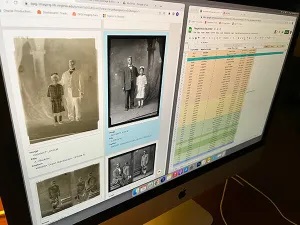 Evans and her team took their photographic reproductions of the glass-plate negatives and created “artist’s renderings” of the portraits using Photoshop, dramatically improving their tonal range.
Evans and her team took their photographic reproductions of the glass-plate negatives and created “artist’s renderings” of the portraits using Photoshop, dramatically improving their tonal range.
Evans, a photographer who has nearly 30 years of experience scanning negatives and working in digital imaging, said that when comparing the original scans of the negatives in Virgo to the images her team created, the tonal range of the portraits has dramatically improved. “On a personal note,” she said, “John Mason and I have been friends in the Charlottesville photo community for many years. It’s an honor to work with him on this project.”
Brandon Butler, the Library’s Director of Information Policy, conducted extensive research on copyright issues pertaining to the Holsinger collection to prepare for the exhibition. “Perhaps surprisingly, some portraits in the Holsinger Studio Collection are still subject to copyright regulations more than 100 years after they were created,” Butler said. “We believe the portrait copyrights belonged to whoever paid to have them taken — often the subject or a relative. Because that right would endure for 120 years, the descendants of the portrait sitters may still hold rights to their ancestors’ images.”
Mason and Library staff members urge exhibition visitors who might recognize ancestors or have any information about the portrait subjects to email the team at
HolsingerStudio@virginia.edu. A brochure of the portraits will be freely available at the opening, and the Holsinger Project website, built by IATH, will live on after the exhibition ends in June 2023. With further support from the Jefferson Trust grant, the Holsinger Studio Project will continue to bring the portraits into the local community, visiting schools, religious organizations, and civic groups. An exhibition at the Jefferson School African American Heritage Center curated by Andrea Douglas, the center’s Executive Director, is in development.
“We want to change the way that everyone in central Virginia sees our shared history,” Mason said.
Public exhibition opening details
By the time that he registered for the World War I draft, Frank W. Robertson (b. 1893) had relocated from North Garden, in Albemarle County, to White Sulphur Springs, West Virginia. There he worked at an attendant in a resort hotel, as did many young Black men from central Virginia. In the late 1910s, Frank moved to the Pittsburgh, Pennsylvania, area, working first as a manual laborer and later as a grocery store clerk.
The public opening celebration for “Visions of Progress: Portraits of Dignity, Style, and Racial Uplift” will be held on Sept. 22 in the Main Gallery of UVA’s Albert and Shirley Small Special Collections Library from 5-8 p.m.
John Edwin Mason will host two rounds of gallery talks that evening: one at 5:30 p.m., another at 6:30 p.m.
Kendall King and Jalane Schmidt, curators of another UVA Library exhibition, “No Unity Without Justice: Student and Community Organizing During the 2017 Summer of Hate,” will speak in the First Floor Gallery at 6 and 7 p.m.
This event is free, but registration is required: 100 tickets will be released via EventBrite for the 5:30/6:00 talks, and another 100 for the 6:30/7:00 talks. Register here: https://Visions-UVA.eventbrite.com
A shuttle will run from the Jefferson School African American Center to the Albert and Shirley Small Special Collections Library at UVA every 30 minutes from 4-8 p.m. for the public opening celebration on September 22, 2022. Registered attendees may also request a code to park for free in the Central Grounds Garage.
For reporters
For press inquiries, please contact Elyse Girard at elyse@virginia.edu.
SHARE THIS:
For more information, please visit the following link:
Pop-up exhibition of African American photo portraits featured in UVA Today
In “academic engagement”
Posted on March 17, 2022 by Mitch Farish
The identity of a young African American woman wearing a flowered hat and a lacey blouse, looking out from a photo portrait taken over a century ago, is a mystery under investigation. It’s only one of the Holsinger studio photos of African Americans on display through March in a pop-up exhibition in the Northside branch of the Jefferson-Madison Regional Library, part of the Holsinger Portrait Project, a partnership of UVA and the Jefferson School African American Heritage Center.
John Edwin Mason and others are on a mission to share these images of local African Americans via the Holsinger Portrait Project. (Photos by Sanjay Suchak, University Communications)
The exhibition is a teaser, according to project co-director, associate history professor John Edwin Mason, “with just enough information to give context for those viewers who haven’t seen the images or known about the Holsinger Studio Collection” — a collection of over 9,000 camera negatives taken in the early 20th century, held by the Albert and Shirley Small Special Collections Library.
“The library exhibition is just one component of this forthcoming effort,” said Holly Robertson, exhibitions coordinator of UVA’s Special Collections Library. “It is supported by the Jefferson Trust, the University Library, the Institute for Advanced Technology in the Humanities and the Department of History. There will be an exhibition at the Jefferson School and a broad community engagement program with events, programs and exterior art installations.”
Read more about the exhibition and the Holsinger Portrait Project in the UVA Today article Pop-Up Exhibit of African American Portraits Highlights Pride, Hints at History.
SHARE THIS:
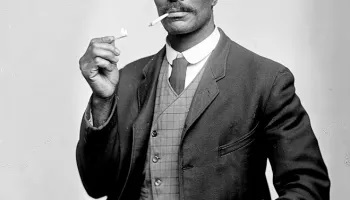 UVA Today spotlights study of African Americans in photos from Library Holsinger Collection
UVA Today spotlights study of African Americans in photos from Library Holsinger Collection
March 7, 2019
In “News”
Congratulations to recipients of the 2022-23 Course Enrichment Grants!
From Judith Thomas, Director of Faculty Programs The Library is pleased to announce recipients of Course Enrichment Grants for 2022-2023. The Course Enrichment Grant (CEG) program supports faculty who would like to enhance their students’ abilities to seek, evaluate, manage, and use information and data, as well as create new kinds…
May 11, 2022
In “Announcement”
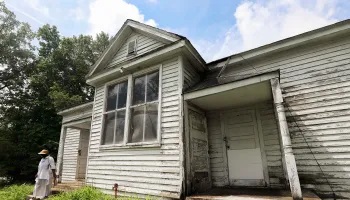 Preserving a piece of African American history
Preserving a piece of African American history
November 10, 2021
In “News”
This entry was posted in Uncategorized and tagged academic engagement, African American, Albert and Shirley Small Special Collections Library, collaboration, history, Holsinger collection, IDEA by Mitch Farish. Bookmark the permalink.
Pop-Up Exhibit of African American Portraits Highlights Pride, Hints at History
By Anne E. Bromley, anneb@virginia.edu
March 16, 2022
Facebook Twitter Email
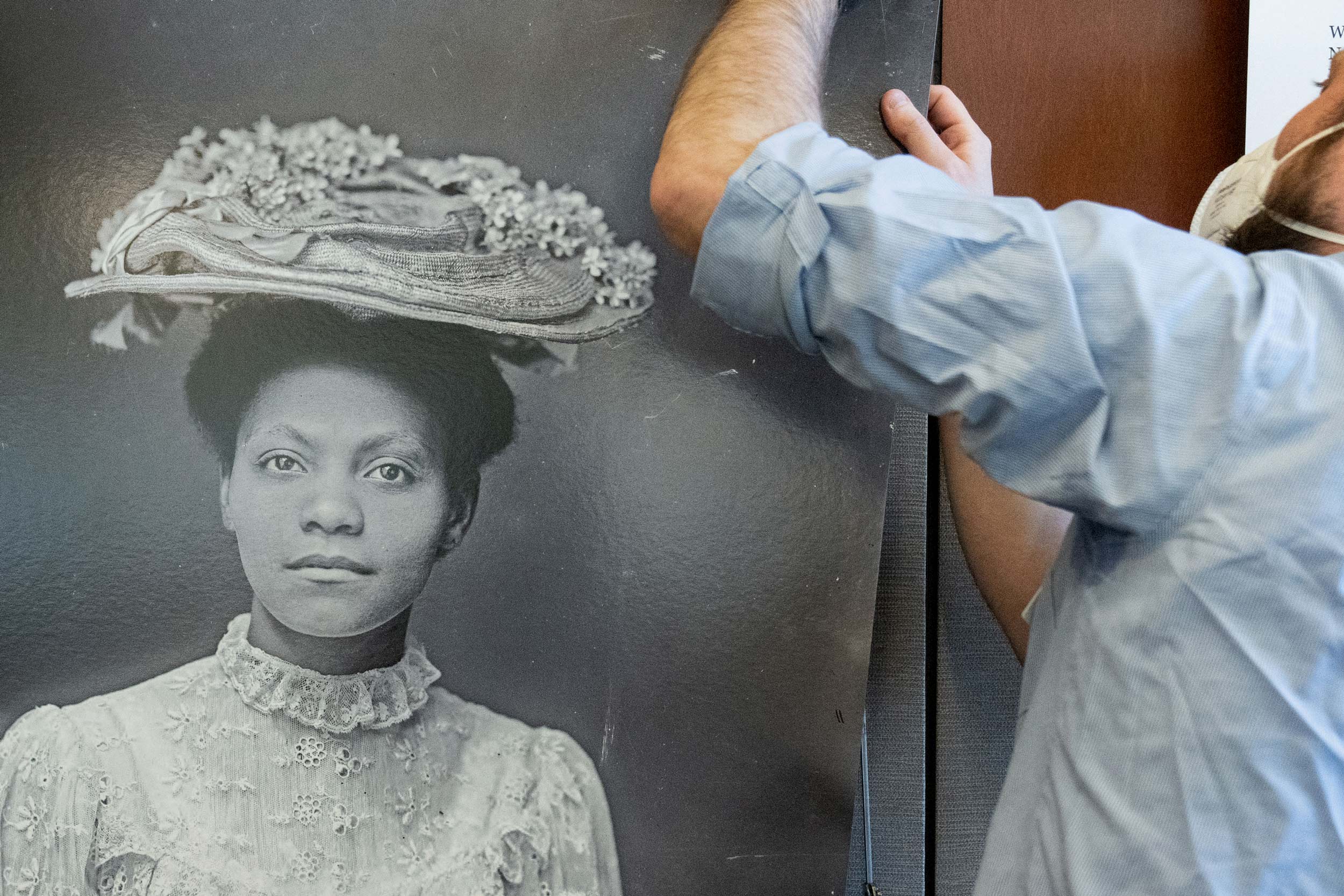
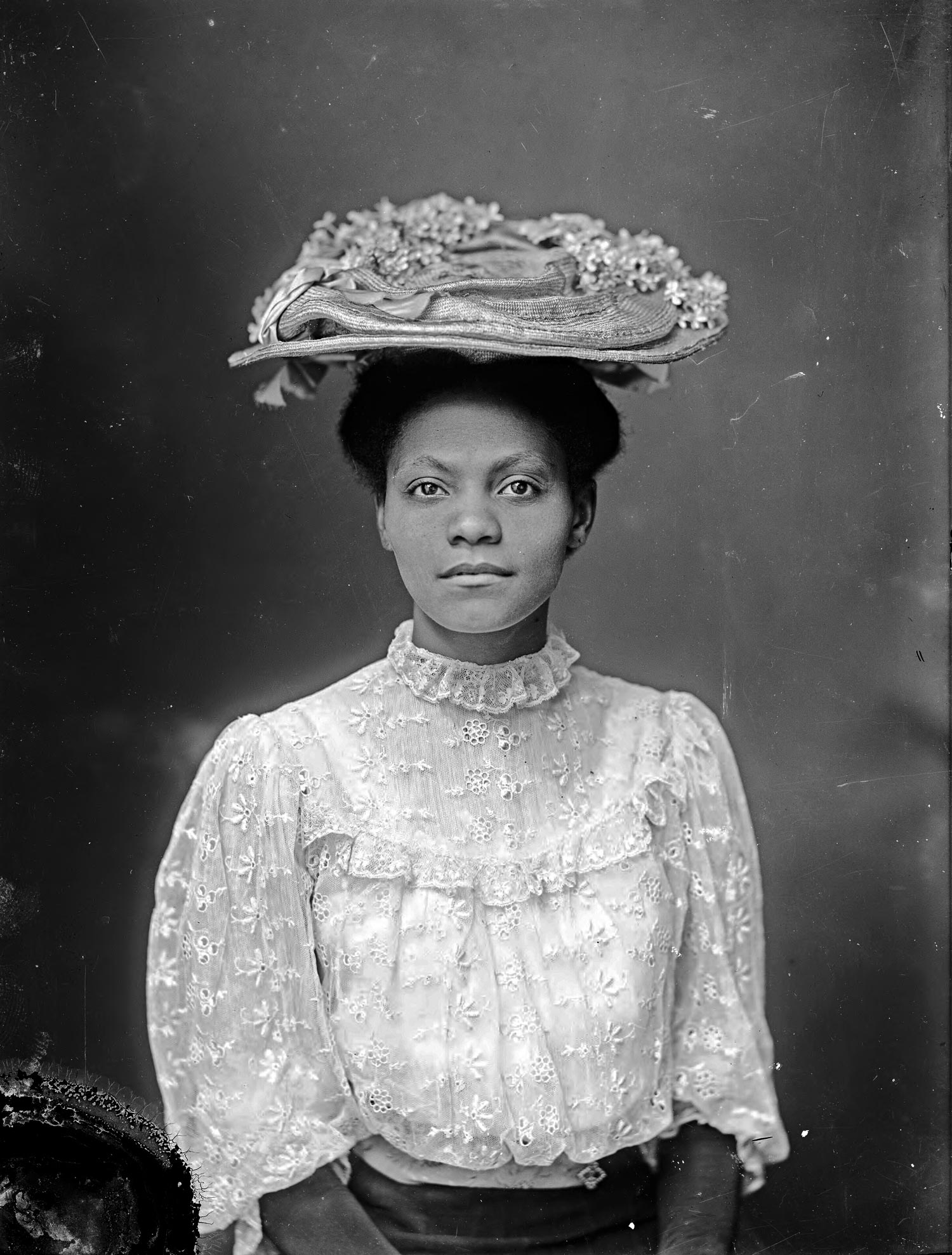 John Edwin Mason and others are on a mission to share these images of local African Americans via the Holsinger Portrait Project. (Photos by Sanjay Suchak, University Communications)
John Edwin Mason and others are on a mission to share these images of local African Americans via the Holsinger Portrait Project. (Photos by Sanjay Suchak, University Communications)
Wearing a stiff hat adorned with small flowers and a fine, lacey blouse, the lone woman gazes directly into the lens – and hence at the viewer, her expression as enigmatic as the Mona Lisa’s.
Her identity is currently a mystery, one of the many unknowns surrounding the subjects of about 500 portraits of local African Americans who commissioned the Holsinger Studio, owned by professional Charlottesville photographer Rufus W. Holsinger, to take their pictures in the early 20th century.
University of Virginia associate history professor John Edwin Mason and others, including scholars, students and community members, are on a mission to share these images and perhaps solve some of those mysteries via the Holsinger Portrait Project. A partnership between UVA and the Jefferson School African American Heritage Center, the collaborative project is based on the Holsinger Studio Collection, held in the University’s Albert and Shirley Small Special Collections Library.
A new pop-up exhibition that displays a selection of the portraits through the month of March is set up to entice the public at the Northside branch of the Jefferson-Madison Regional Library.
Mason considers the exhibit a teaser – with just enough information to give context for those viewers who haven’t seen the images or known about the Holsinger Studio Collection.
RELATED STORY
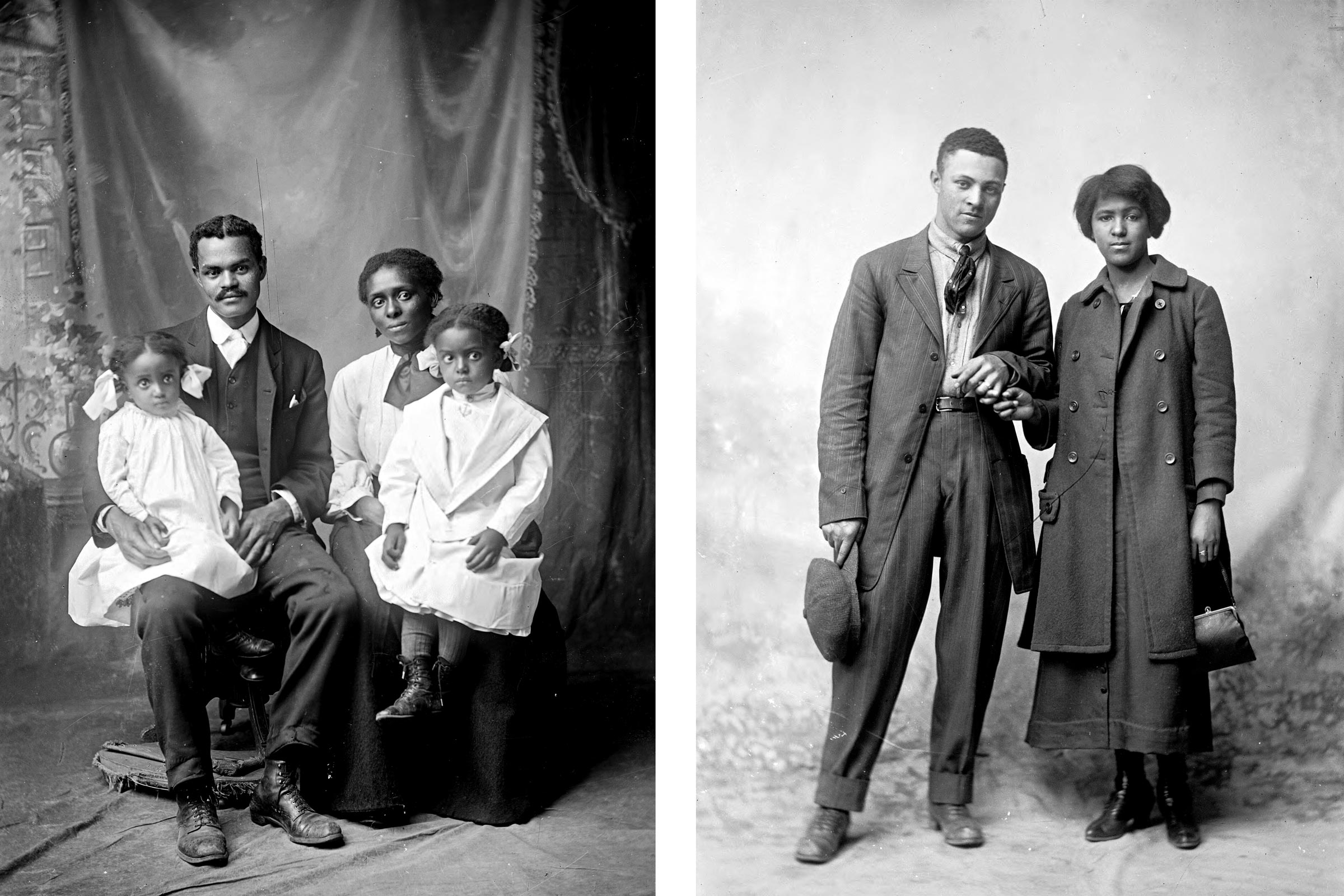 Snapshots of Local History, Displayed Anew
Snapshots of Local History, Displayed Anew
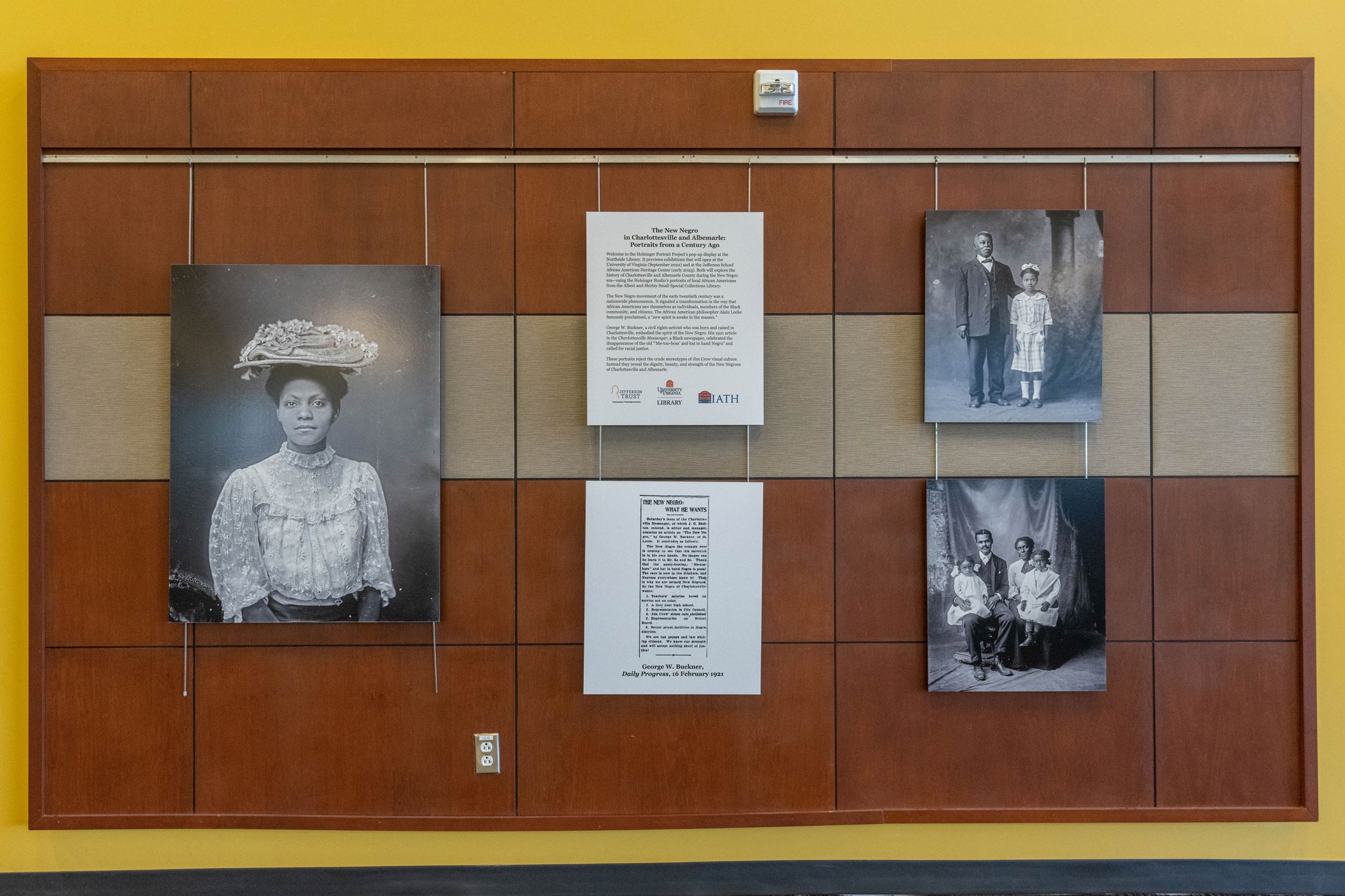 The Holsinger Studio’s portraits of African Americans were made around the same time as the New Negro movement, described in the exhibit.
The Holsinger Studio’s portraits of African Americans were made around the same time as the New Negro movement, described in the exhibit.
Although the woman in the hat is unidentified, Mason and researchers have a suspicion about who she is, but are still trying to nail it down, he said. He hopes they can identify her and say more about her life when a more comprehensive exhibition opens in the fall.
A studio fire in 1912 destroyed the Holsinger Studio’s early business ledgers and some negatives, leaving many people in the portraits unidentified. The library collection, acquired in 1978, comprises approximately 9,000 dry-plate glass negatives and 500 celluloid negatives.
“With the Holsinger Portrait Project, we want to change the way people see our history – and I mean, see it literally and understand it,” said Mason, who is co-director of the project. “The exhibition is a way of telling history that doesn’t start with oppression, but with beauty, style, grace and dignity.”
Nowadays it’s commonplace to share selfies taken with smartphones on social media, but it was a big deal to get a photographic portrait made 100 or so years ago. The African Americans in the Holsinger Studio portraits clearly look like they wanted to show themselves in the best light, as a counterweight to the discriminatory forces leading to Jim Crow laws, restrictions and segregation, Mason said.
Mason studies and teaches the history of photography and has focused on early 19th-century South African history and South African popular culture, including the Cape Town New Year’s Carnival. Several years ago, he served as vice chair of Charlottesville’s Blue Ribbon Commission on Race, Memorials and Public Spaces. National Geographic magazine approached Mason in 2018, asking if he would help the magazine examine and acknowledge the racist coverage that predominated so much of its 130-year history.
Researching and promoting the work of photographer Rufus W. Holsinger, who moved to Charlottesville in the 1880s and lived there until his death in 1930, has been occupying Mason in recent years.
Holsinger turned his lens on Charlottesville, capturing both daily life and pivotal moments such as the burning of the Rotunda in 1895. He ran a successful studio, employing about 20 workers, including other photographers. They also took thousands of portraits, including approximately 500 portraits of African American residents in Charlottesville and the surrounding area. (His son Ralph took over the studio and ran it until retiring in 1969 and selling the business, which operated until 1977.)
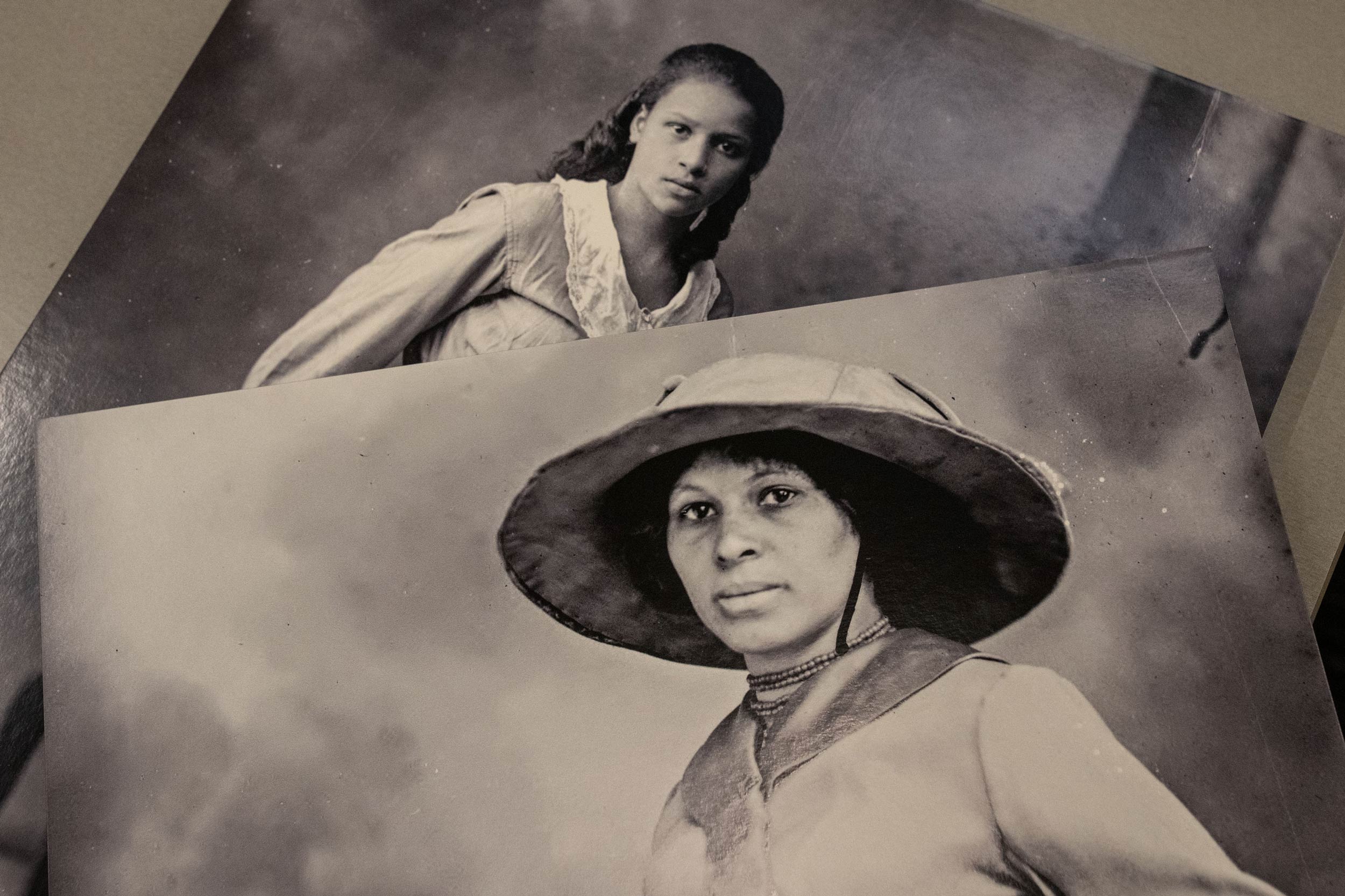 Individuals and families usually posed in the Holsinger Studio.
Individuals and families usually posed in the Holsinger Studio.
In addition to individual portraits, there are couples, small groups, families and babies. Photographs were mostly posed in the studio, but some were also staged outdoors. Everyone is dressed up in suits and ties, beautiful dresses, white blouses and sometimes jewelry or hats.
“When you look at these portraits, you don’t see oppression. You see family love, romantic love, strength, grace, dignity – despite oppression,” Mason said.
Mason wants to show that no matter how bad it got, Black people were not crushed. “With self-consciousness, they used the camera as a weapon against white supremacy,” he said.
Similarities can be found between the civil rights activism that ramped up in the 1950s and this earlier time, when activism was presented as the “New Negro” movement, according to Mason, who describes it in the exhibit.
The “New Negro” movement was a nationwide movement whose leaders, such as Booker T. Washington and W.E.B. Dubois, were writing and speaking out to show that Black people were part of “a new spirit,” Mason said.
“They were more assertive, standing independent on their own two feet, less afraid of white supremacy, demanding their equal share of civil rights,” he said.
 John Edwin Mason, UVA associate professor of history, co-directs the Holsinger Portrait Project and curated this exhibit at Northside Library.
John Edwin Mason, UVA associate professor of history, co-directs the Holsinger Portrait Project and curated this exhibit at Northside Library.
Around this time, African American organizations – including the National Association for the Advancement of Colored People, or NAACP – emerged and flourished, looking for ways to fight for Black people’s rights.
“This is all happening when Jim Crow’s getting worse,” Mason said. “The Ku Klux Klan was rising and active locally by 1920, crosses are being burned, statues being erected, etc. It was front-page news in the Daily Progress. The newspaper reported on the Klan as if they were the Chamber of Commerce.”
Local activities of Black organizations were connected to national actions. The Holsinger exhibit includes commentary published by George W. Buckner, a civil rights activist and businessman who was born and raised in Charlottesville. In 1921, Buckner published a manifesto, “The New Negro: What He Wants,” in the local Black newspaper, The Messenger. It also was reprinted in the Daily Progress.
The Holsinger Studio portraits of African Americans who exemplified the virtues of the New Negro amplify Buckner’s words, Mason said.
In a tweet about the exhibit, Mason wrote, “For most of the 20th century, ‘Negro’ was the term that most African Americans preferred. That changed in the 1960s, when ‘Black,’ ‘Afro-American’ and ‘African American’ came into common usage. But early in the century, when the portraits were made, ‘Negro’ signified race pride.”
The Northside exhibit, which is free and open during the library’s regular hours, was originally planned for spring 2020, but the pandemic put it on hold. The Northside Library, located at 705 West Rio Road, is open Monday through Thursday from 10 a.m. to 9 p.m. and on Fridays and Saturdays from 10 a.m. to 5 p.m.
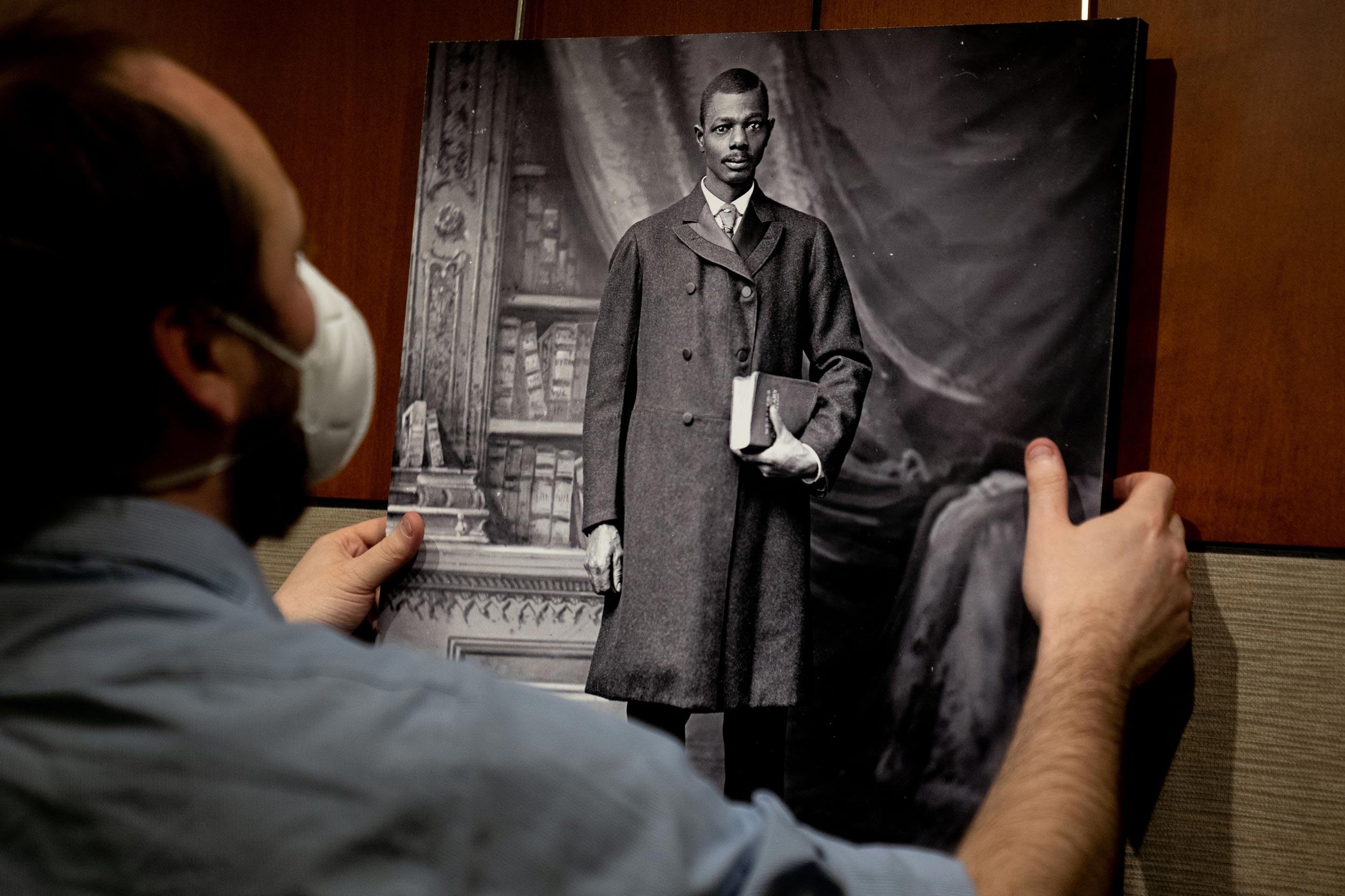 Evan Stankovics, adult programming and supervising reference librarian at Northside, helped set up the exhibit.
Evan Stankovics, adult programming and supervising reference librarian at Northside, helped set up the exhibit.
This exhibit is a preview of a more extensive exhibition being planned for later this year at the UVA Special Collections Library and next year at the Jefferson School African American Heritage Center.
“The library exhibition is just one component of this forthcoming effort,” Holly Robertson, exhibitions coordinator of UVA’s Special Collections Library, said. “It is supported by the Jefferson Trust, the University Library, the Institute for Advanced Technology in the Humanities and the Department of History. There will be an exhibition at the Jefferson School and a broad community engagement program with events, programs and exterior art installations.”
In addition to a Jefferson Trust grant, the Holsinger Portrait Project is supported by a 3 Cavaliers grant, which Mason shares with a pair of UVA colleagues: religious studies professor Jalane Schmidt, who directs the UVA Democracy Initiative’s Memory Project; and architectural historian Louis Nelson, vice provost for academic outreach. The grants have also helped pay for five students doing research to find out as much about the people in the portraits as possible, part of ongoing efforts to tell Charlottesville history, as well as their stories.
The fall exhibit will have more information about the portraits’ subjects and will be accompanied by a brochure with essays that contextualize local and national history, Mason said. The Institute for Advanced Technology in the Humanities also will create a new website to go with the collection, Worthy Martin, interim director of IATH, said. The website that currently exists was created for an earlier program before the pandemic.
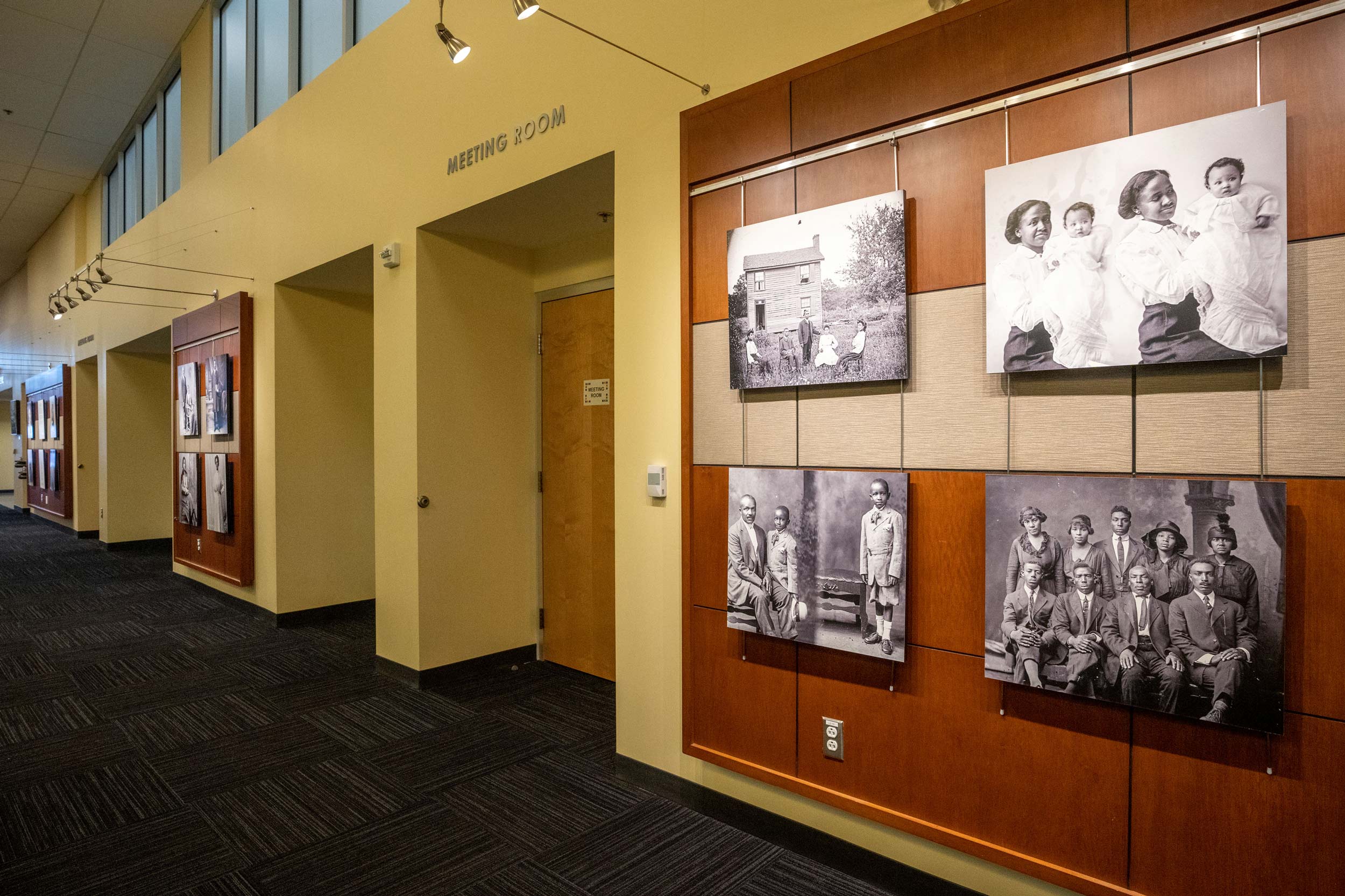 Many of the Holsinger Studio’s portrait subjects from the early 20th century are unidentified.
Many of the Holsinger Studio’s portrait subjects from the early 20th century are unidentified.
They are working with community advisers and descendants to help shape the exhibit, Mason said. “We want to make sure when we display ancestors, we’re doing it respectfully and with permission, if possible.
“We’ll talk about the individuals – many had remarkable lives, and it’s important to remember them.”
MEDIA CONTACT
University News AssociateOffice of University Communications
anneb@virginia.edu (434) 924-6861
For more information, please visit the following link:
YOU MAY ALSO LIKE
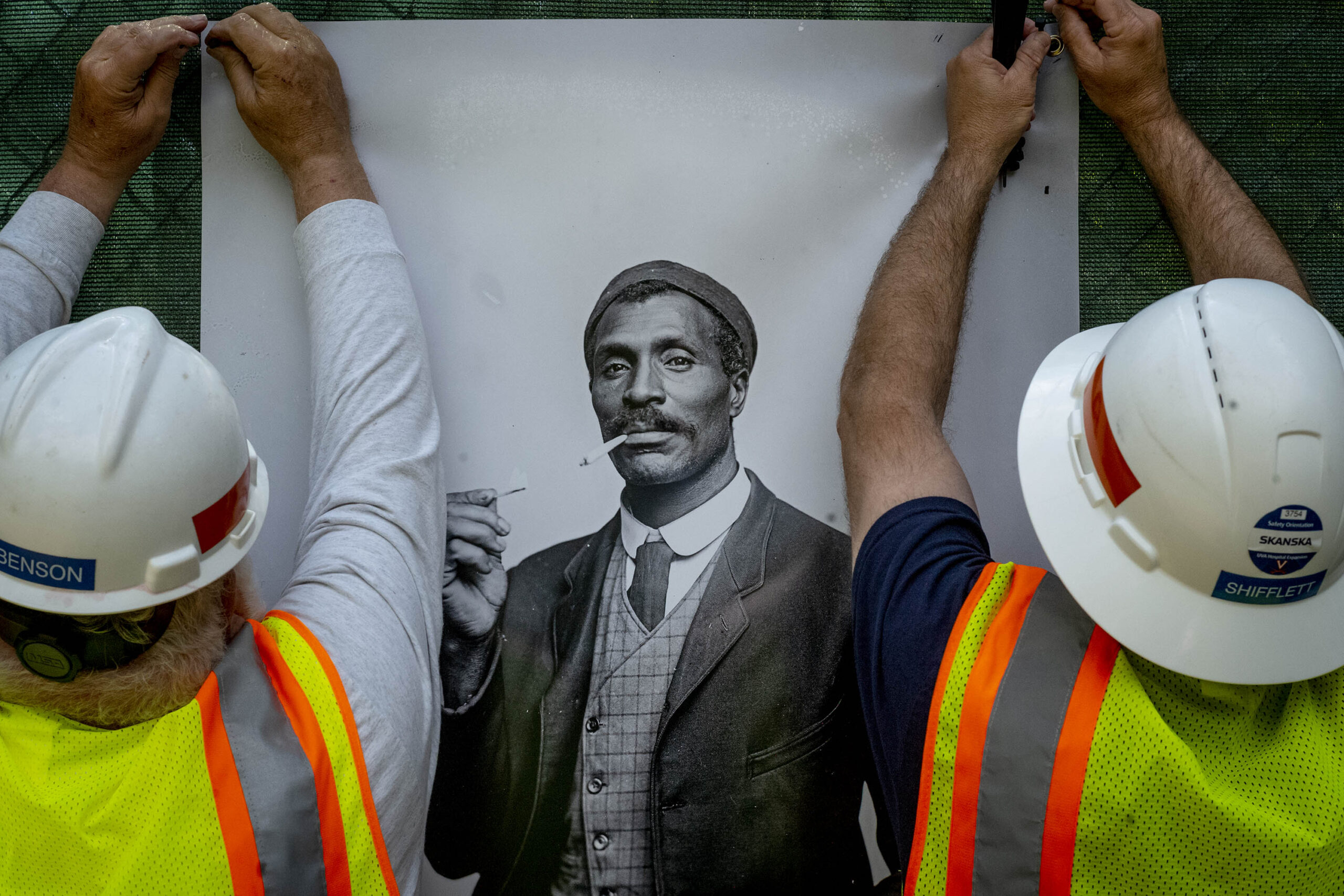 Photos: Powerful Portraits for a Powerful Site
Photos: Powerful Portraits for a Powerful Site
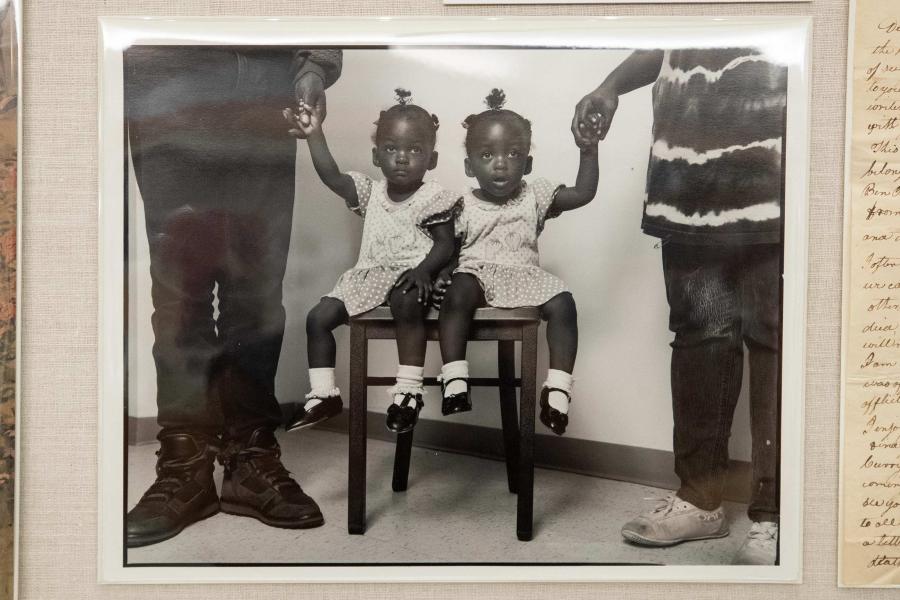 Exhibit Celebrates Black Sisterhood Through the Centuries
Exhibit Celebrates Black Sisterhood Through the Centuries
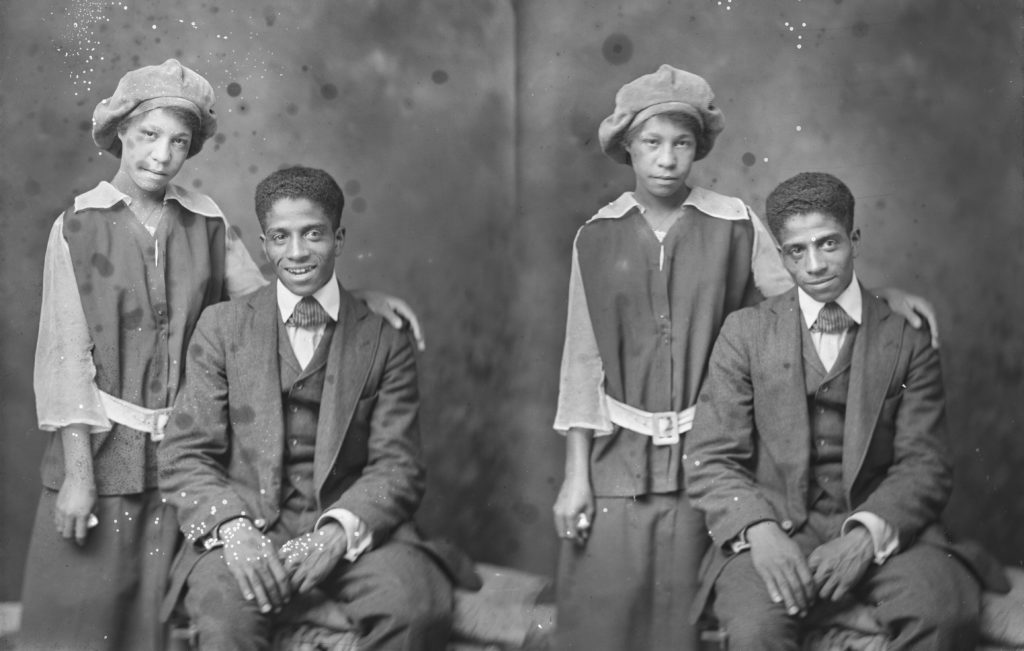 Images of ‘Black life, Black joy,’ are immortalized in historic Charlottesville portraits | PBS NewsHour
Images of ‘Black life, Black joy,’ are immortalized in historic Charlottesville portraits | PBS NewsHour
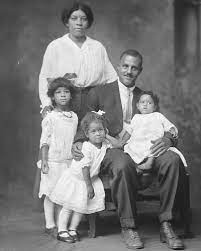 Holsinger Studio | Portrait Project – The University of Virginia
Holsinger Studio | Portrait Project – The University of Virginia
Holsinger Studio | Portrait Project – Related events
Revolutionary Black portrait exhibition opens at UVa
While Charlottesville erected Confederate monuments, hundreds of African American residents were sitting for professional portraits
Revolutionary Black portrait exhibition opens at UVa
Portraits of African American families in the early 1900s | Daily Mail Online
Portraits of African American families in the early 1900s | Daily Mail Online
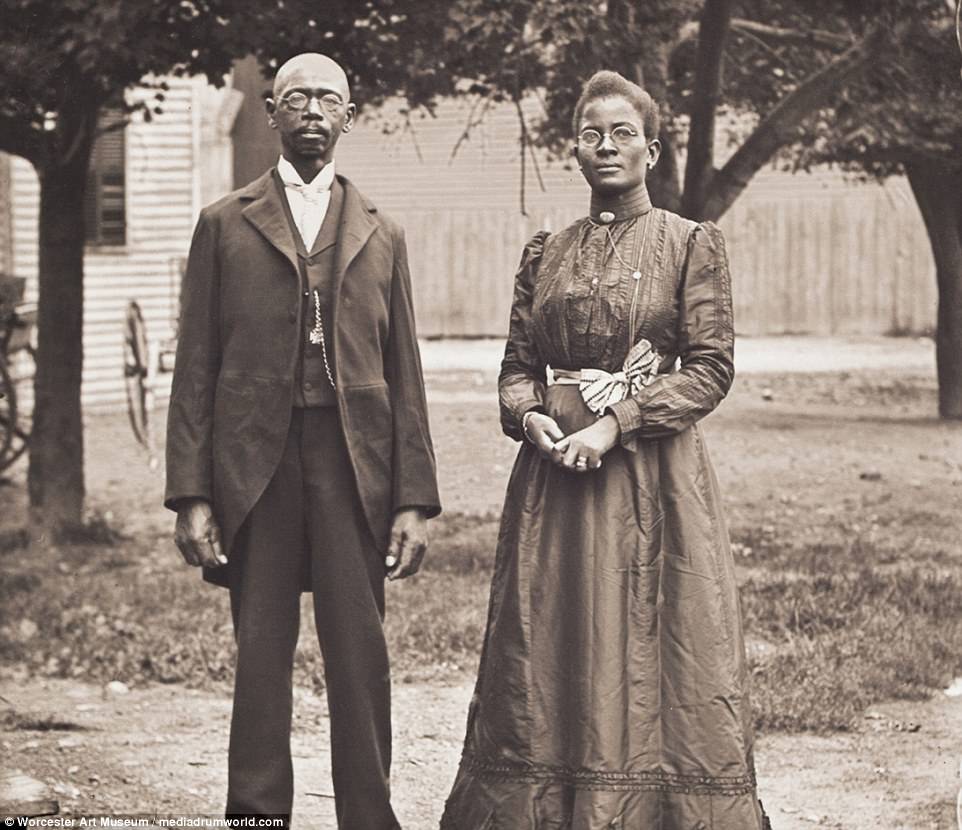 Portraits of African American families in the early 1900s | Daily Mail Online
Portraits of African American families in the early 1900s | Daily Mail Online
Credit: © Worcester Art Museum / mediadrumworld.com
 Portraits of African American families in the early 1900s | Daily Mail Online
Portraits of African American families in the early 1900s | Daily Mail Online
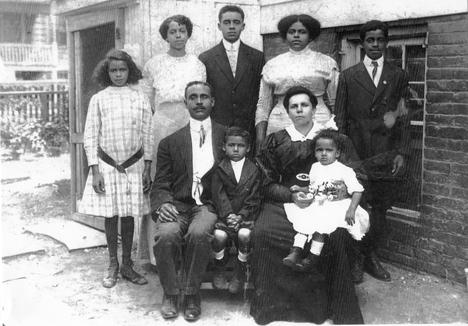 Mayors Message E-News Updates – <h3>African American History in Nyack</h3>
Mayors Message E-News Updates – <h3>African American History in Nyack</h3>
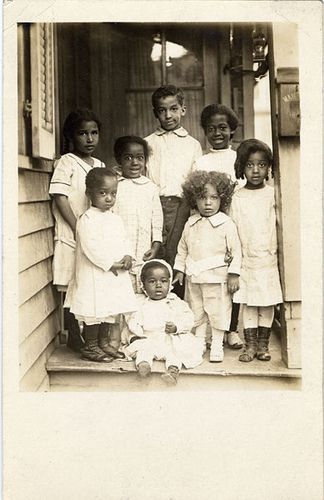 440 Blast from the Past ideas | history, african american history, american history
440 Blast from the Past ideas | history, african american history, american history
 The Historical Legacy of Juneteenth | National Museum of African American History and Culture
The Historical Legacy of Juneteenth | National Museum of African American History and Culture
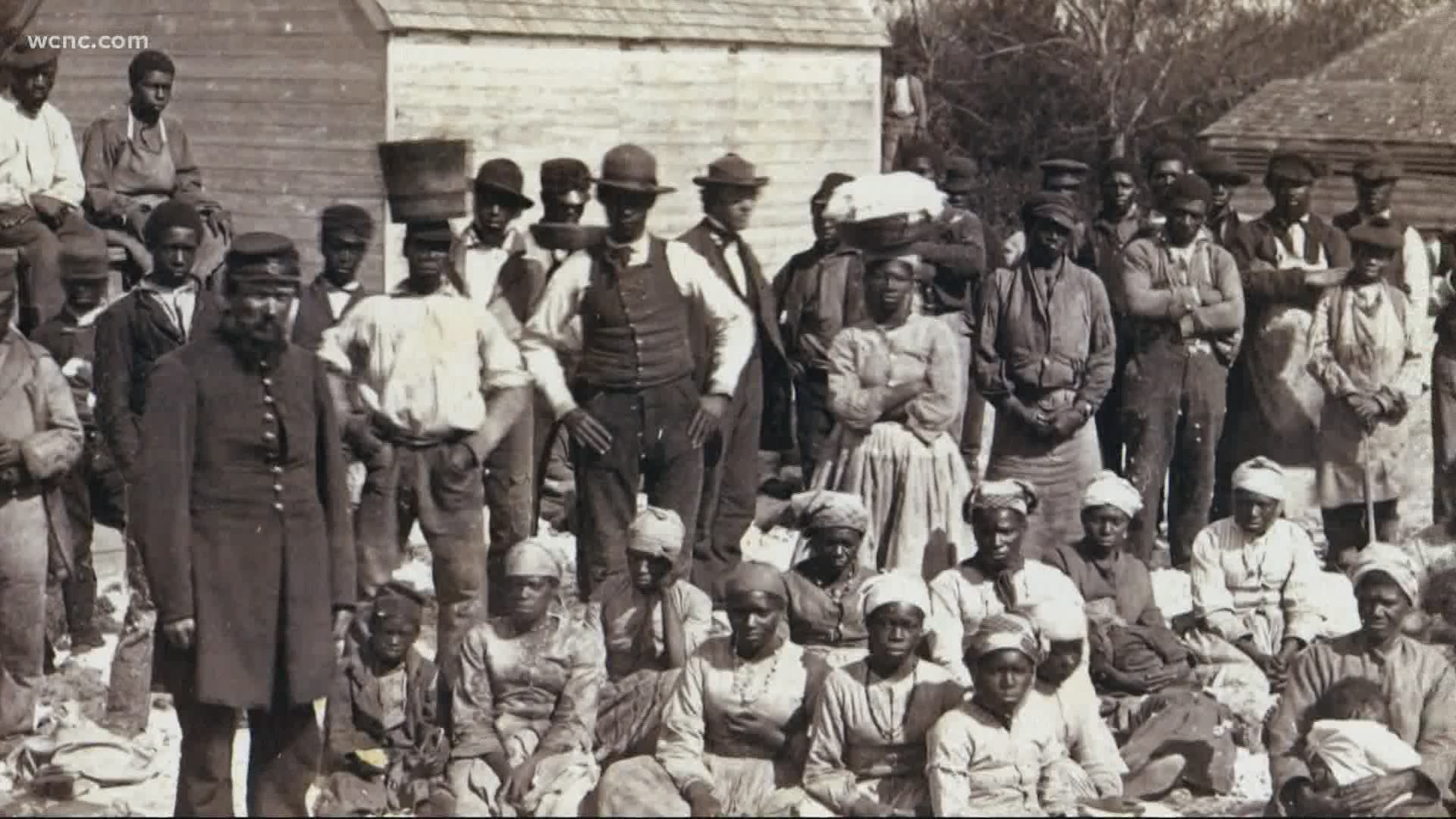 Juneteenth celebrations underway across the country today
Juneteenth celebrations underway across the country today
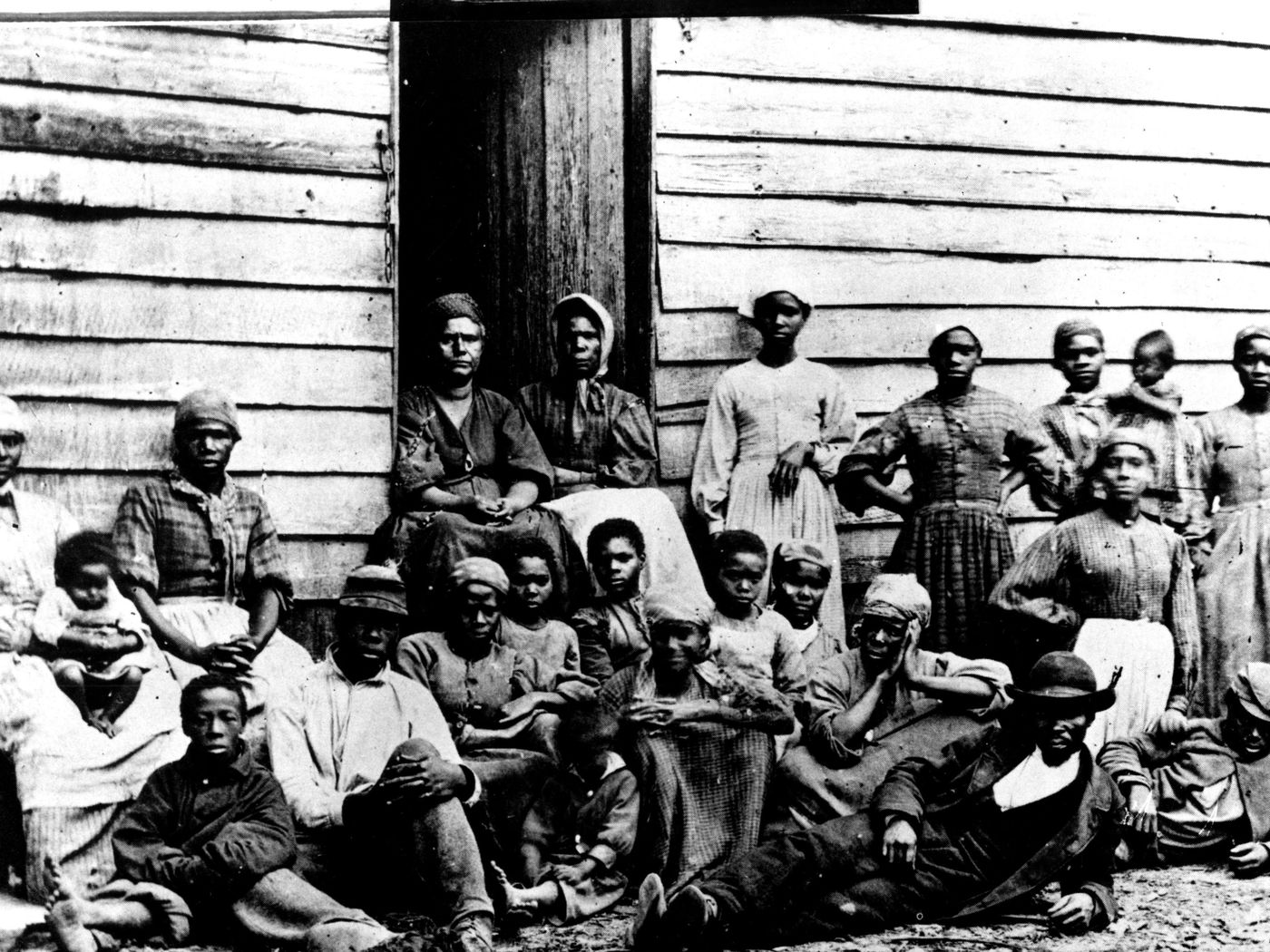 Juneteenth: why celebrating the holiday is more important now than ever – Vox
Juneteenth: why celebrating the holiday is more important now than ever – Vox
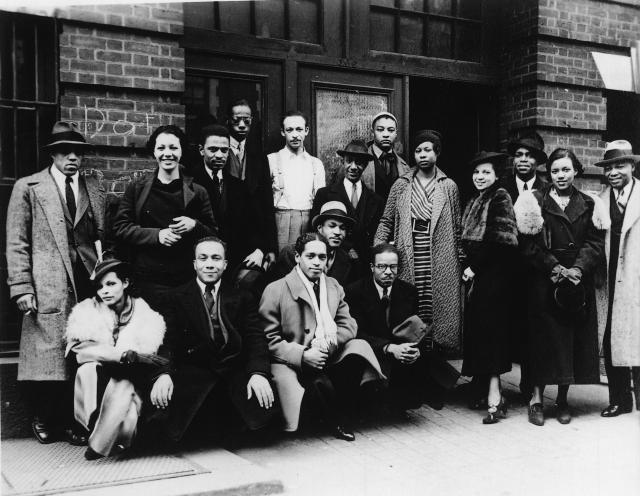 The Artists of the Harlem Renaissance | The Phillips Collection
The Artists of the Harlem Renaissance | The Phillips Collection
 Harlem Renaissance – Definition, Artists & How It Started – HISTORY
Harlem Renaissance – Definition, Artists & How It Started – HISTORY
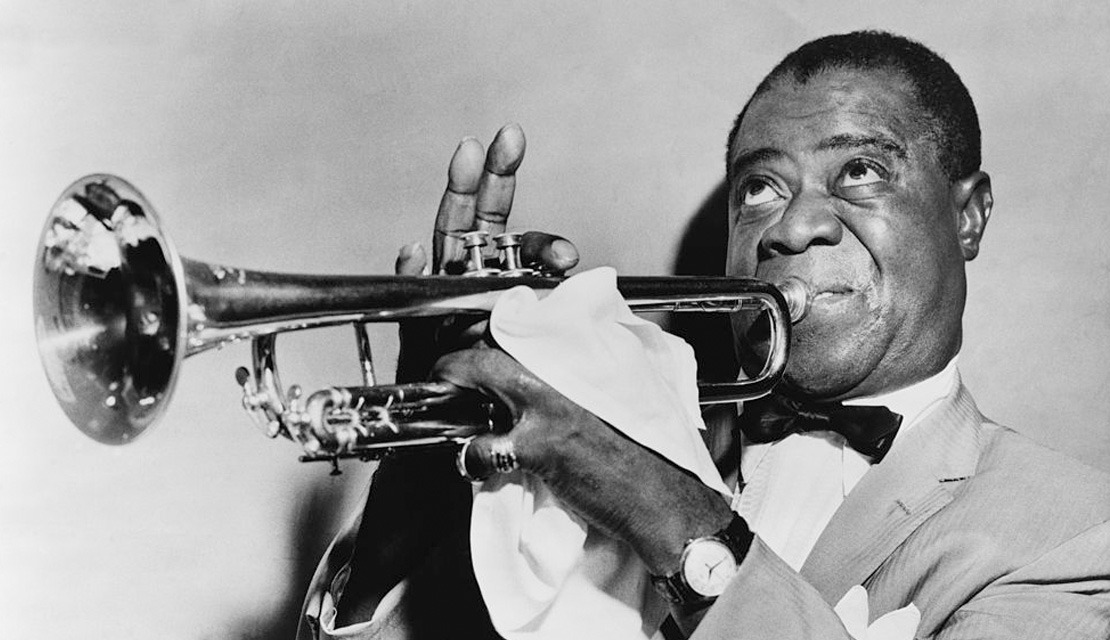 Heroes of The Harlem Renaissance | Welcome to the Harlem Standard
Heroes of The Harlem Renaissance | Welcome to the Harlem Standard
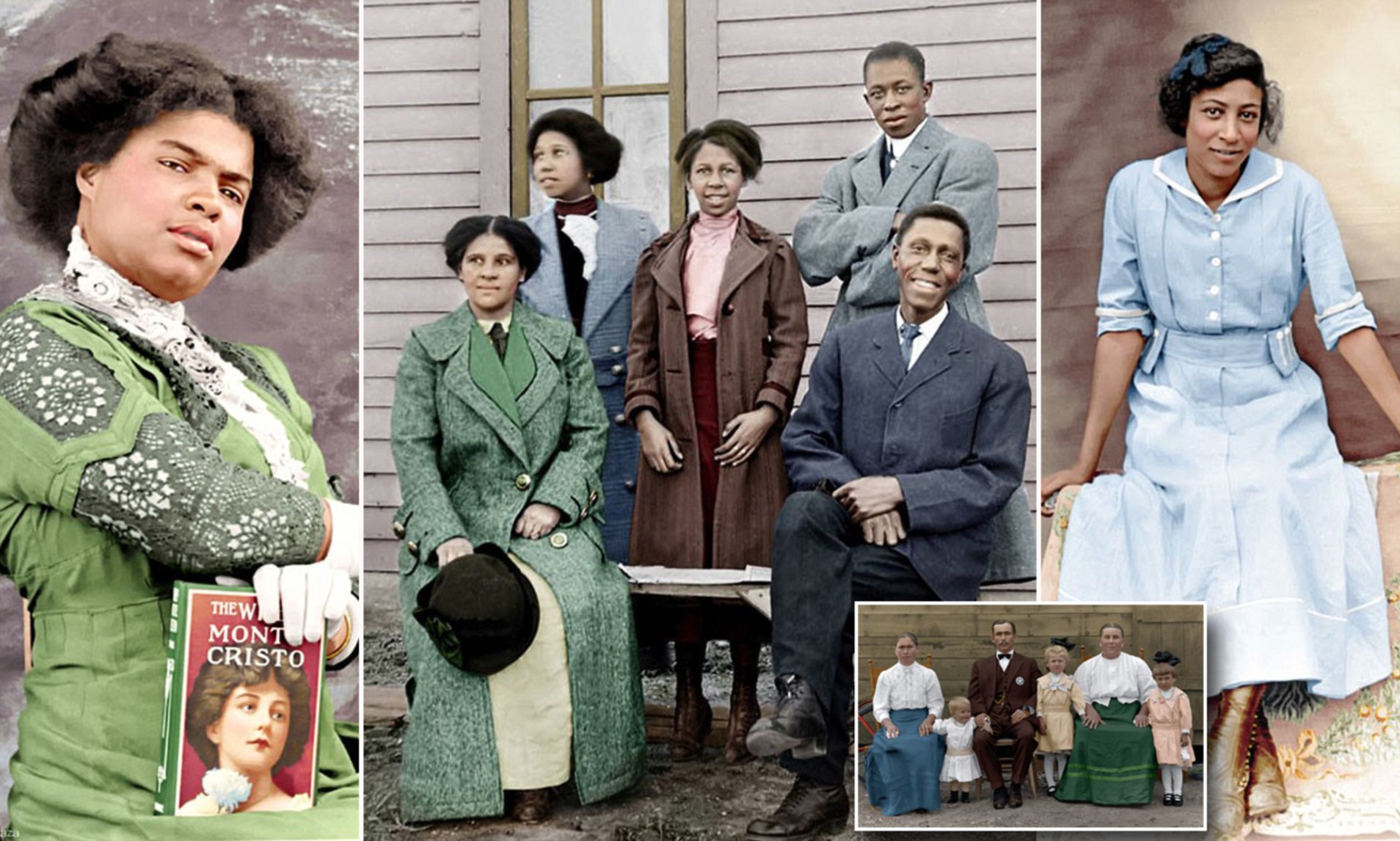 Photos of African Americans in early 1900s Nebraska are colorized | Daily Mail Online
Photos of African Americans in early 1900s Nebraska are colorized | Daily Mail Online
Frederick Douglass, ca. 1879. George K. Warren. (National Archives Gift Collection)
Exact Date Shot Unknown
NARA FILE #: 200-FL-22
WAR & CONFLICT BOOK #: 113
Frederick Douglass – Wikipedia
 Black History Milestones: Timeline – HISTORY
Black History Milestones: Timeline – HISTORY
While Charlottesville erected Confederate monuments, hundreds of African American residents were sitting for professional portraits
Images of ‘Black life, Black joy,’ are immortalized in historic Charlottesville portraits 7:24 mins
PBS NewsHour 8,549 views Feb 24, 2023
The University of Virginia’s Holsinger Studio Portrait Project is currently on exhibit, showcasing portraits of Black Charlottesville residents from the Jim Crow era. The goal, head curator John Edwin Mason said, is to show a side of Black history that is often ignored in retellings. “We have not learned about Black life, Black joy, Black family, Black churches, Black schools, Black politics, Black style. All of those things have been in the background,” he said. “And through these portraits, we’re bringing them into the foreground.” This video was produced by Casey Kuhn, Rachel Liesendahl, Nicole Ellis, Yasmeen Alamiri and Julia Griffin. Graphics by Megan McGrew. Portraits provided by the Albert and Shirley Small Special Collections Library. Other video courtesy University of Virginia, Virginia Public Media and Maupintown Media. Stream your PBS favorites with the PBS app: https://to.pbs.org/2Jb8twG Find more from PBS NewsHour at https://www.pbs.org/newshour Subscribe to our YouTube channel: https://bit.ly/2HfsCD6 Follow us: TikTok: https://www.tiktok.com/@pbsnews Twitter: http://www.twitter.com/newshour Instagram: http://www.instagram.com/newshour Facebook: http://www.pbs.org/newshour Subscribe: PBS NewsHour podcasts: https://www.pbs.org/newshour/podcasts Newsletters: https://www.pbs.org/newshour/subscribe
The HistoryMakers: Documenting Black history through first-person accounts | 60 Minutes 60 Minutes 6,347 views Feb 20, 2023 #60Minutes #News #BlackHistory
Julieanna Richardson’s organization is documenting the breadth of the Black experience in America, one story at a time. #60Minutes #News #BlackHistory “60 Minutes” is the most successful television broadcast in history. Offering hard-hitting investigative reports, interviews, feature segments and profiles of people in the news, the broadcast began in 1968 and is still a hit, over 50 seasons later, regularly making Nielsen’s Top 10. Subscribe to the “60 Minutes” YouTube channel: http://bit.ly/1S7CLRu Watch full episodes: http://cbsn.ws/1Qkjo1F Get more “60 Minutes” from “60 Minutes: Overtime”: http://cbsn.ws/1KG3sdr Follow “60 Minutes” on Instagram: http://bit.ly/23Xv8Ry Like “60 Minutes” on Facebook: http://on.fb.me/1Xb1Dao Follow “60 Minutes” on Twitter: http://bit.ly/1KxUsqX Subscribe to our newsletter: http://cbsn.ws/1RqHw7T Download the CBS News app: http://cbsn.ws/1Xb1WC8 Try Paramount+ free: https://bit.ly/2OiW1kZ For video licensing inquiries, contact: licensing@veritone.com
How Larry Wilmore’s 30 years in TV have shaped comedy and challenged traditional notions 7:51 mins
PBS NewsHour 2,634 views Feb 23, 2023
Your favorite TV comedies likely owe a lot to Larry Wilmore, the creator or guiding force behind some of the most popular and most impactful shows over the last 30 years. Geoff Bennett spoke with home about how his work challenged traditional notions of politics, race, and comedy, in the process, helping to shape the broader cultural conversation. It’s part of our arts and culture series, CANVAS. Stream your PBS favorites with the PBS app: https://to.pbs.org/2Jb8twG Find more from PBS NewsHour at https://www.pbs.org/newshour Subscribe to our YouTube channel: https://bit.ly/2HfsCD6 Follow us: Facebook: http://www.pbs.org/newshour Twitter: http://www.twitter.com/newshour Instagram: http://www.instagram.com/newshour Subscribe: PBS NewsHour podcasts: https://www.pbs.org/newshour/podcasts Newsletters: https://www.pbs.org/newshour/subscribe
How this all-Black swim team is making waves in college sports 5:55 mins
PBS NewsHour 9,651 views Feb 19, 2023
Competitive swimming is often dominated by white athletes, but one school is trying to change that. Since 2016, Howard University has been the only historically Black school with a swim team. Today, only 2 percent of all college swimmers are Black. Swim coach Nicholas Askew joins Stephanie Sy to discuss Howard’s push to create more diversity in the sport. Stream your PBS favorites with the PBS app: https://to.pbs.org/2Jb8twG Find more from PBS NewsHour at https://www.pbs.org/newshour Subscribe to our YouTube channel: https://bit.ly/2HfsCD6 Follow us: Facebook: http://www.pbs.org/newshour Twitter: http://www.twitter.com/newshour Instagram: http://www.instagram.com/newshour Subscribe: PBS NewsHour podcasts: https://www.pbs.org/newshour/podcasts Newsletters: https://www.pbs.org/newshour/subscribe
How an enslaved man helped create these iconic monuments in Washington, D.C. 4:22 mins
PBS NewsHour 11,747 views Feb 18, 2023
Some of Washington, D.C.’s most familiar landmarks were built with the labor of enslaved people, their accomplishments largely lost to history. In part three of our series, “Hidden Histories,” we learn about one of those enslaved laborers, a sculptor named Philip Reed. Stream your PBS favorites with the PBS app: https://to.pbs.org/2Jb8twG Find more from PBS NewsHour at https://www.pbs.org/newshour Subscribe to our YouTube channel: https://bit.ly/2HfsCD6 Follow us: Facebook: http://www.pbs.org/newshour Twitter: http://www.twitter.com/newshour Instagram: http://www.instagram.com/newshour Subscribe: PBS NewsHour podcasts: https://www.pbs.org/newshour/podcasts Newsletters: https://www.pbs.org/newshour/subscribe
Man freed after 28 years in prison reflects on wrongful murder conviction 10:20 mins
15,866 views Feb 17, 2023
Earlier this week, a St. Louis judge overturned the murder conviction of Lamar Johnson, who spent nearly 28 years behind bars for a crime he didn’t commit. John Yang first profiled Johnson’s case in 2021 and spoke with him again Friday just days after his release from prison. It’s part of our series Searching for Justice. Stream your PBS favorites with the PBS app: https://to.pbs.org/2Jb8twG Find more from PBS NewsHour at https://www.pbs.org/newshour Subscribe to our YouTube channel: https://bit.ly/2HfsCD6 Follow us: TikTok: https://www.tiktok.com/@pbsnews Twitter: http://www.twitter.com/newshour Instagram: http://www.instagram.com/newshour Facebook: http://www.pbs.org/newshour Subscribe: PBS NewsHour podcasts: https://www.pbs.org/newshour/podcasts Newsletters: https://www.pbs.org/newshour/subscribe
New book ‘Half American’ details struggle of Black soldiers in World War II and back home 6:52 mins
PBS NewsHour 7,345 views Feb 16, 2023
The stories of American soldiers fighting wars have been immortalized in movies and books throughout the years. Yet they have left out in great detail the contributions of Black soldiers. Historian Matthew Delmont takes a closer look at this in his new book. He joined Amna Nawaz to discuss “Half American: The Epic Story of African Americans Fighting World War II at Home and Abroad.” Stream your PBS favorites with the PBS app: https://to.pbs.org/2Jb8twG Find more from PBS NewsHour at https://www.pbs.org/newshour Subscribe to our YouTube channel: https://bit.ly/2HfsCD6 Follow us: Facebook: http://www.pbs.org/newshour Twitter: http://www.twitter.com/newshour Instagram: http://www.instagram.com/newshour Subscribe: PBS NewsHour podcasts: https://www.pbs.org/newshour/podcasts Newsletters: https://www.pbs.org/newshour/subscribe
How Robert Smalls sailed his crew and family to freedom during the Civil War 4:32 mins
PBS NewsHour 17,390 views Feb 11, 2023
During the transatlantic slave trade, Charleston, South Carolina was one of the largest slave ports in the United States. But at the height of the Civil War, Charleston’s waterfront was the backdrop of one enslaved man’s daring escape. In part two of our series, “Hidden Histories,” we get the story of Robert Smalls, who stole a Confederate ship and sailed to freedom. Stream your PBS favorites with the PBS app: https://to.pbs.org/2Jb8twG Find more from PBS NewsHour at https://www.pbs.org/newshour Subscribe to our YouTube channel: https://bit.ly/2HfsCD6 Follow us: Facebook: http://www.pbs.org/newshour Twitter: http://www.twitter.com/newshour Instagram: http://www.instagram.com/newshour Subscribe: PBS NewsHour podcasts: https://www.pbs.org/newshour/podcasts Newsletters: https://www.pbs.org/newshour/subscribe
A Brief But Spectacular take on improving community health outcomes near urban highways 3:16 mins
PBS NewsHour 9,631 views Jan 19, 2023 Brief but Spectacular
Amy Stelly is an urban planner, designer and artist in New Orleans where her family has lived for four generations. She has been fighting to remove the Claiborne Expressway, a highway that the Biden administration has called “an example of historic inequity.” She shares her Brief But Spectacular take on improving community health outcomes near urban highways. Stream your PBS favorites with the PBS app: https://to.pbs.org/2Jb8twG Find more from PBS NewsHour at https://www.pbs.org/newshour Subscribe to our YouTube channel: https://bit.ly/2HfsCD6 Follow us: TikTok: https://www.tiktok.com/@pbsnews Twitter: http://www.twitter.com/newshour Instagram: http://www.instagram.com/newshour Facebook: http://www.pbs.org/newshour Subscribe: PBS NewsHour podcasts: https://www.pbs.org/newshour/podcasts Newsletters: https://www.pbs.org/newshour/subscribe
A Brief But spectacular take on centering Black leadership in climate change solutions 3:17 mins
PBS NewsHour 5,783 views Jul 2, 2022 Brief but Spectacular
Heather McTeer Toney spent three years leading the Environmental Protection Agency for the southeastern United States. She now continues her advocacy for the environment both nationally and worldwide. She shares her Brief But Spectacular take on centering Black leadership in climate change solutions. Stream your PBS favorites with the PBS app: https://to.pbs.org/2Jb8twG Find more from PBS NewsHour at https://www.pbs.org/newshour Subscribe to our YouTube channel: https://bit.ly/2HfsCD6 Follow us: Facebook: http://www.pbs.org/newshour Twitter: http://www.twitter.com/newshour Instagram: http://www.instagram.com/newshour Subscribe: PBS NewsHour podcasts: https://www.pbs.org/newshour/podcasts Newsletters: https://www.pbs.org/newshour/subscribe
A Columbia University professor’s Brief But Spectacular take on Black life and literature 3:43 mins
PBS NewsHour 7,106 views Apr 26, 2022 Brief but Spectacular
Columbia University professor Farah Jasmine Griffin was deeply troubled by the political turmoil happening across the U.S. during the 2016 presidential campaign. She began writing a literary memoir, “Read Until You Understand,” which explores what democracy means for the lives and work of Black authors and activists, and herself. Here’s her Brief But Spectacular take on Black life and literature. Stream your PBS favorites with the PBS app: https://to.pbs.org/2Jb8twG Find more from PBS NewsHour at https://www.pbs.org/newshour Subscribe to our YouTube channel: https://bit.ly/2HfsCD6 Follow us: Facebook: http://www.pbs.org/newshour Twitter: http://www.twitter.com/newshour Instagram: http://www.instagram.com/newshour Subscribe: PBS NewsHour podcasts: https://www.pbs.org/newshour/podcasts Newsletters: https://www.pbs.org/newshour/subscribe
Neil deGrasse Tyson & Malcolm Gladwell – AI, Autonomous Vehicles, and Race – Oh my! 55:51 mins
StarTalk 2.24M subscribers
216,393 views Jul 15, 2021 StarTalk Podcast Full Episodes
How do self-driving cars change our psychology and do they solve The Trolley Problem? On this episode, Neil deGrasse Tyson and comic co-host Chuck Nice philosophize about science’s role in society with prolific author Malcolm Gladwell. What’s the best way for scientists to communicate with the public? Learn about Malcolm’s new book, The Bomber Mafia (https://amzn.to/30JnKSo), and about incorporating science into writing. Should every scientist also be a science communicator? Should all areas of science be made accessible to the public? We debate the popularity of Stephen Hawking’s A Brief History of Time (https://amzn.to/32hVDu2) and the role of pseudoscience in American science history. As a society, are we pulling away from scientific literacy? We talk about Malcolm’s mother growing up in Jamaica and why he loves the city of Atlanta. Neil and Malcolm compare notes about school growing up and discuss demographic disparities in school suspensions. Malcolm breaks down the concept of his new book about the quest to create accurate bombing in the second world war. Discover General Curtis LeMay and why he is one of the deadliest people in human history. You’ll also learn… how to make a mini firestorm on a birthday cake? Why is Malcolm running in front of self-driving cars? We break down the changes in psychology between cars and pedestrians when it comes to autonomous vehicles. If the fear of an imperfect driver is removed, will pedestrians behave differently? Does the self-driving car revolution also hail in pedestrian anarchy? Should autonomous vehicles be less good at driving? Do self-driving cars have a trolley problem? Does programmer bias have the potential to put certain people more at risk of accidents? All that plus, find out the evolution of Malcolm’s hair. Thanks to our Patrons Tobias Malmborg, Andy Pattinson, Adam Lenda, Naomi Martin, Johan Fredrik Oldervik, and Scott Heflen for supporting us this week. NOTE: StarTalk+ Patrons can watch or listen to this entire episode commercial-free. Support us on Patreon: https://www.patreon.com/startalkradio FOLLOW or SUBSCRIBE to StarTalk: YouTube: https://www.youtube.com/user/startalk… Twitter: http://twitter.com/startalkradio Facebook: https://www.facebook.com/StarTalk Instagram: https://www.instagram.com/startalkradio/ About StarTalk: Science meets pop culture on StarTalk! Astrophysicist & Hayden Planetarium director Neil deGrasse Tyson, his comic co-hosts, guest celebrities & scientists discuss astronomy, physics, and everything else about life in the universe. Keep Looking Up! #StarTalk #NeildeGrasseTyson

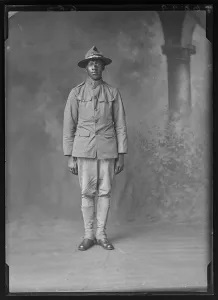


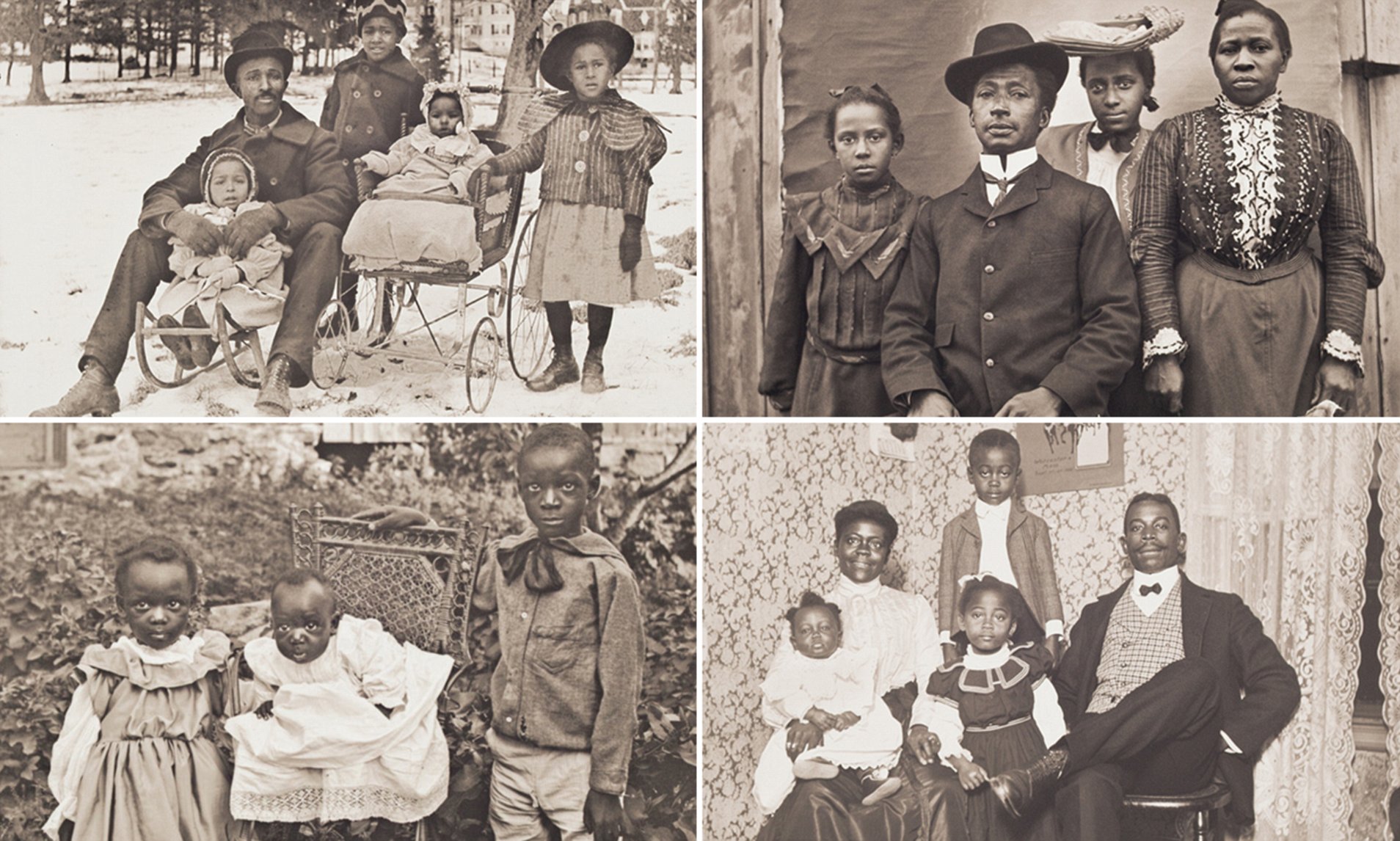
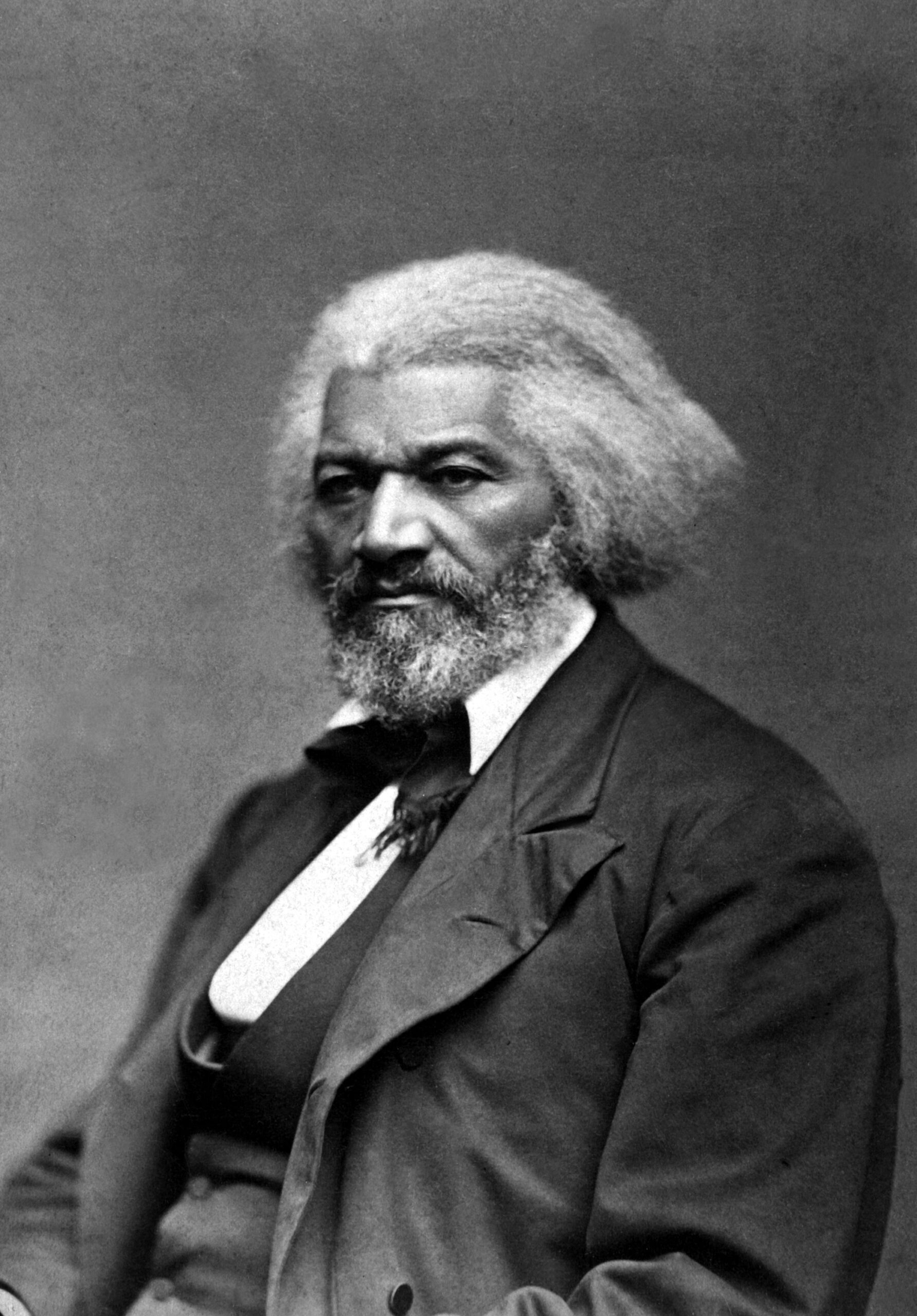
Leave a Reply